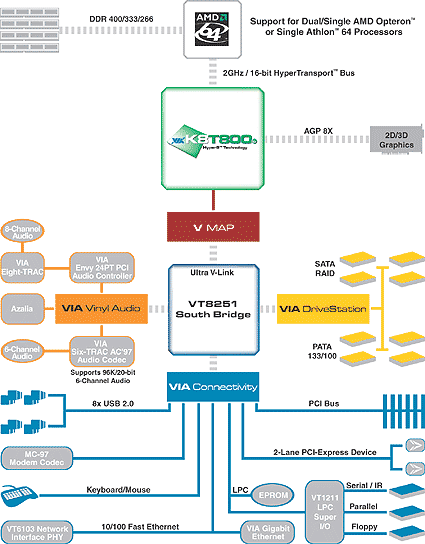VIA's K8T800 Pro Bumps up HyperTransport Speed, But Lacks Punch
VIA's K8T800 Pro In Detail
A diagram of the chipset shows the new Southbridge VT8251 that will be available by midyear - unfortunately VIA's reference motherboard was still equipped with the old VT8237 device.
The chipset's modifications include the integration of four serial ATA data links instead of the previous two, through which the Raid Mode 0+1 (synchronous stripping and mirroring) is made possible. ATAPI drives are supported as well.
Furthermore, the two UltraATA/133 ports remain unaffected - the competitor, Intel, is preparing to launch only one of them in the ICH6 by midyear. VIA christened its optional data connectivity links for mass memory "DriveStation."
On the opposite side of the diagram you will find VIA's vinyl audio interface. Here, manufacturers can either choose a low priced AC97 codec (2.1) or a full-fledged PCI sound chip. New is the support of Intel's Azalia audio specification, which is known as "High Definition Audio" nowadays, and offers native support for eight-channel Dolby Pro Logic IIx. This is also possible, though, with VIA's Envy 24PT.
The other interfaces for the keyboard, mouse, USB 2.0 (8 ports), modem codec and 100 MBit network controller still remain.
Other new features include an interface for VIA's gigabit Ethernet chip and two PCIe ports with 2 lanes (250 MB/s per port). Incorporating even more of these new interfaces would not make sense, as the connection between the Northbridge and Southbridge using the V-map interface with 533 MB/s would reach its maximum capacity if all of the interfaces were to be used simultaneously.
Additionally, the HyperTransport bus can reach speeds of up to 1 GHz, both up and downstream, compared to its predecessor's maximum speed of 800 MHz. VIA achieved this with what it calls Hyper8, which inhibits signal noise and bumps up clock speeds.
Get Tom's Hardware's best news and in-depth reviews, straight to your inbox.
Current page: VIA's K8T800 Pro In Detail
Prev Page VIA K8T800 Pro's Faster HyperTransport Bus Next Page Athlon64 Chipsets Compared
Patrick Schmid was the editor-in-chief for Tom's Hardware from 2005 to 2006. He wrote numerous articles on a wide range of hardware topics, including storage, CPUs, and system builds.

